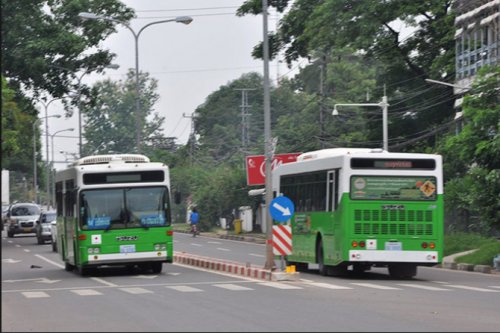Creating Vientiane Bus Lanes Will Encourage More Passengers
More people will choose to ride on public buses in Vientiane if there are designated bus lanes on roads.
Transportation on two or four-lane roads in Vientiane is currently open to all general vehicles. However, Vientiane Public Works and Transport department has plans to create bus lanes to allow public transport to cut through traffic congestion.
Vice Mayor of Vientiane Mr Keophilavanh Arphaylath discussed with transport officials in Vientiane if public transport could operate services more efficiently keeping to bus timetables, especially during rush hours, then many more people would take public buses in preference to cars, decreasing overall traffic.
“We have 129 public buses including 42 new Japanese buses and this is enough to cover the roads in the city,” Director of Vientiane Capital State Bus Enterprise Mr Khamphoun Temerath told Vientiane Times on Friday. The reason public buses don’t stick to their timetables is due to the traffic jams, he explained.
“On the route from the Bus Station to the National University of Laos, most buses depart on time but when they return they are late because of traffic congestion along the way,” he said.
The quantity of people using public buses in the urban area has increased about 20 percent in the last year.
Mr Keophilavanh also noted to transport officials that if the roads had assigned bus lanes many people using their own cars would switch to using public buses because it would save them time and money and do less damage to the environment.
The traffic situation in Vientiane is becoming increasingly frustrating for city dwellers, especially in the rush hour when the streets become clogged and accidents are frequent.
The rapid socio-economic growth has led to a surge in the number of vehicles on the roads.
In 2013 there were 1.4 million vehicles registered nationwide, with the annual average increase in vehicle numbers standing at 15 percent. There are now over 604,600 vehicles in Vientiane alone. This is almost half the total number of vehicles in Laos.
To tackle the rising accident rate and ease traffic congestion, the Lao government is overhauling its policies and spending a huge amount on the construction and improvement of infrastructure, especially in Vientiane.
It may be necessary to construct park and ride facilities in the city to reduce traffic congestion in the future, according to project workers from the Vientiane Sustainable Urban Transport Project.
Nowadays, the problem of traffic congestion in Vientiane is getting worse and worse, and the lack of parking spaces is one of the chief causes of the congestion.
When drivers have nowhere to park they often park their cars encroaching on to the sidewalks or on the roads, and this necessarily slows traffic to a crawl in some parts of the city
The traffic now backs up along many routes in Vientiane and the problem is increasing daily due to poor management, insufficient parking spaces, and the lack of reliable on time public transport. Designated bus lanes would greatly aid buses in keeping to their schedules.
It’s possible that people will change their minds and stop using their own vehicles, switching to public and non-motorised transport in the next decade, when more transport options become available.
Source: Vientiane Times

